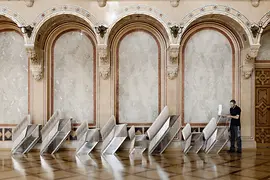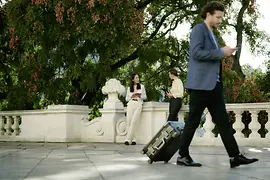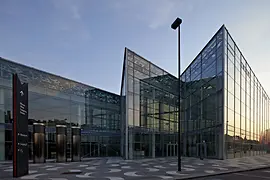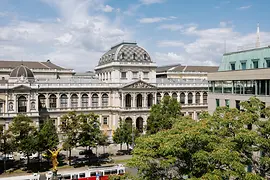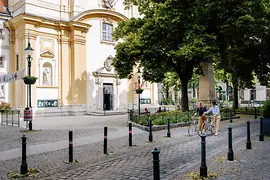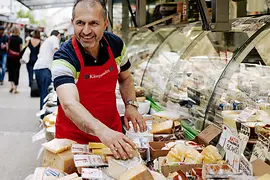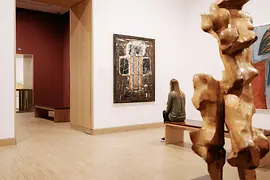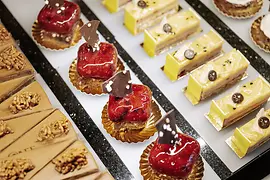All of Vienna: memorable meetings, authentic people and pure enjoyment once again
The themes covered below are intended to provide you with a starting point for additional research and discussions with your contacts in the media.
Meeting in Vienna
Vienna is a popular place for meetings, and not just thanks to its convenient location in the heart of Europe. Here, work and play are two sides of the same coin. In 2019, almost 6,000 congresses, meetings and events took place in the capital, earning Vienna sixth place in the annual International Congress and Convention Association (ICCA) rankings. Unusual event venues brimming with imperial charm – as well as state-of-the-art office set ups – not only make Vienna a popular destination for business travelers, but also an attractive place for companies and other organizations to locate. Not least because of its world-class research infrastructure. In 2019 the headquarters of around 200 international groups were based in Vienna. The United Nations and more than a dozen UN organizations have been enjoying the city’s hospitality and the advantages that make it such an exceptional place to live and work for many years. In fact, Vienna has a long history of providing a neutral stage for global diplomacy: from the Congress of Vienna at the Hofburg in 1814/15 and the signing of the Austrian State Treaty at the Belvedere in 1955 to the summit meeting between US President John F. Kennedy and the Soviet Premier Nikita Khruschchev in 1961 and the Iran nuclear deal negotiated at Palais Coburg in 2015.
Numerous art and cultural institutions in the city provide a rich source of inspiration and continue to draw in both artists and art lovers. Visitors can enjoy outstanding, world-class cuisine at the capital’s 153 award-winning establishments, while the traditional taverns and restaurants provide an authentic taste of down-to-earth Viennese hospitality. Unique communal meeting places embedded in the fabric of the city, Vienna’s 2,250 coffeehouses, 3,500 outdoor cafes and restaurants, countless sausage stands and around 100 Heuriger wine taverns offer pure escapism, while making a vital contribution to quality of life in the city.
Feeling Vienna
The taste of Vienna
After everything they have missed out on recently, people cannot wait to treat themselves again, start living life to the full and leave their everyday cares behind. Something that couldn’t be easier in Vienna. Vienna is the capital of enjoyment – and the myriad ways to soak up everything it has to offer are as diverse as the city itself, with all the senses coming into play at some point. In fact, it is the sense of taste that is in its element here, given that Vienna has so many culinary experiences to enjoy: Viennese Cuisine is the only cuisine in the world to be named after a city. Delicacies such as Viennese escargots and offal are as much a part of the palette as Wiener Schnitzel. Cakes and pastries from top Viennese coffeehouses such as Café Central and Café Hawelka are the perfect coffeetime treats. Viennese coffeehouse culture was added to the UNESCO list of Intangible Cultural Assets in 2011, but has been around a lot longer than that – all the way back to the days of the Habsburg empire. To this day, former purveyors of confectionary to the imperial court k.u.k. Hofzuckerbäckerei Demel continues to serve the candied violet petals beloved of Empress Elisabeth.
Strolling in the vineyards also promises a taste sensation: after all, Vienna is the only major city in the world to have a significant winegrowing industry to its credit. There are around 700 hectares under vine, with the famous Wiener Gemischter Satz among the many varieties produced in the capital. With 13 trails covering more than 132 kilometers and providing 44 hours of hiking options, it’s also nice to know that there is never any shortage of opportunities to break for a drink at a wine tavern.
Heaven scent
In Vienna, a deep connection to the natural environment can be felt everywhere. Almost half of the city’s total area is accounted for by green spaces. In the old town there is a park of some description every 250 meters or so! And this is where it becomes clear that Vienna even has its own unique scent: from spring to late summer the rose garden in the Volksgarten is a sight for sore eyes, with the 400 different varieties in bloom here also providing an unforgettable olfactory experience. In fact, some of the scents of Vienna are available in fragrance form at a handful of select stores, such as Kniže. This gentlemen’s outfitter – famously a holder of the coveted former imperial warrant – is located right next door to the J. B. Filz perfumerie in a shop designed by the star Austrian architect Adolf Loos. In the 1920s Kniže was a leading men’s fashion label. And it was at this time that it launched the world’s first fragrance collection for men, Kniže Ten.
The look and feel of Vienna
When it comes to appealing to the visual sense, Vienna has an exceptional wealth of art and cultural institutions. The magnificent interiors of the Kunsthistorisches Museum Vienna, to pick one of countless examples, provide a fitting backdrop for the majestic treasures on show. It is also home to the world’s leading chamber of curiosities which comprises around 2,200 weird and wonderful objects. At the Museum of Natural History, it’s the sense of touch that comes into its own thanks to various hands-on exhibits, including 150-million-year-old petrified dinosaur dung. St. Stephen’s Cathedral also has a number of little-known haptic treasures in store such as the Kolomanistein, a contact relic of St. Coloman, which is said to bring luck to all those who touch it.
The sounds of Vienna
The capital’s concert halls and opera houses provide an unforgettable auditory experience. And the Vienna State Opera is the apotheosis of musical perfection, with performances 300 nights of the year. Music also plays a central role at the 450 formal events held during the Viennese ball season.
The sheer variety of moments of enjoyment that appeal to all the senses in Vienna is overwhelming. So it is also nice to know that the concept of Gemütlichkeit or coziness is hard-wired into the city, as a balance to all that action. It’s no secret that Vienna likes to offer a little too much of everything. But without ever going over the top – preferring instead to trust in its cozy, laid back instincts. And this is the essence of the sixth sense – the Viennese sense: letting it take hold means truly being in tune with the city.
Viennese Originals
The phrase “Viennese Originals” immediately brings the city’s people to mind – and the mysterious “dark soul” so often attributed to the Viennese. Interviews and portraits with famous and lesser-known “originals” reveal what it means to be authentically Viennese – from traditional artisanship courtesy of Viennese manufacturers, to the waitresses at Viennese coffeehouse Demel, the scribe at the Kunsthistorisches Museum Vienna, the carpenter at the Konzerthaus and the people that work for the public utilities such as the legendary MA48 refuse crews. And then there those who have followed callings not found anywhere else on earth such as the Schnitzel pounders at Figlmüller. Every single one of these originals is relatable thanks to the stories they tell, revealing just what the people who call the city home are really like: lovable, a little quirky and sometimes pretty grumpy, too! But they are also cosmopolitan, open and generous. A genuine blend of influences, that taken together add up to something inimitably Viennese.
But it’s not just the people that are true originals here in the capital. The unforgettable art collections at the likes of the Kunsthistorisches Museum, the Belvedere and the Leopold Museum are unique to Vienna. The Belvedere museum is home to the world’s largest collection of paintings by Gustav Klimt. And the Leopold Museum has the world’s largest Egon Schiele collection which comprises 42 paintings and more than 180 original hand drawn works. There are also some very original museum concepts in Vienna, with institutions such as the Third Man Museum, the Esperanto Museum and the Snow Globe Museum.
Major events enjoyed by millions of people each year, hosted as only Vienna knows how, are also worthy of the title “Viennese Originals”: the most obvious candidate being the New Year’s Day Concert by the Vienna Philharmonic which is followed live by 40 million. The Danube Island Festival is Europe’s largest open air festival and the Music Film Festival on Rathausplatz is Europe’s largest open air cultural and culinary event.
Here you will find even more inspiration: allof.vienna.info
Display alternative text
All of Vienna is finally the perfect meeting place for people from all over the world again. Vienna is original and pure pleasure again.

